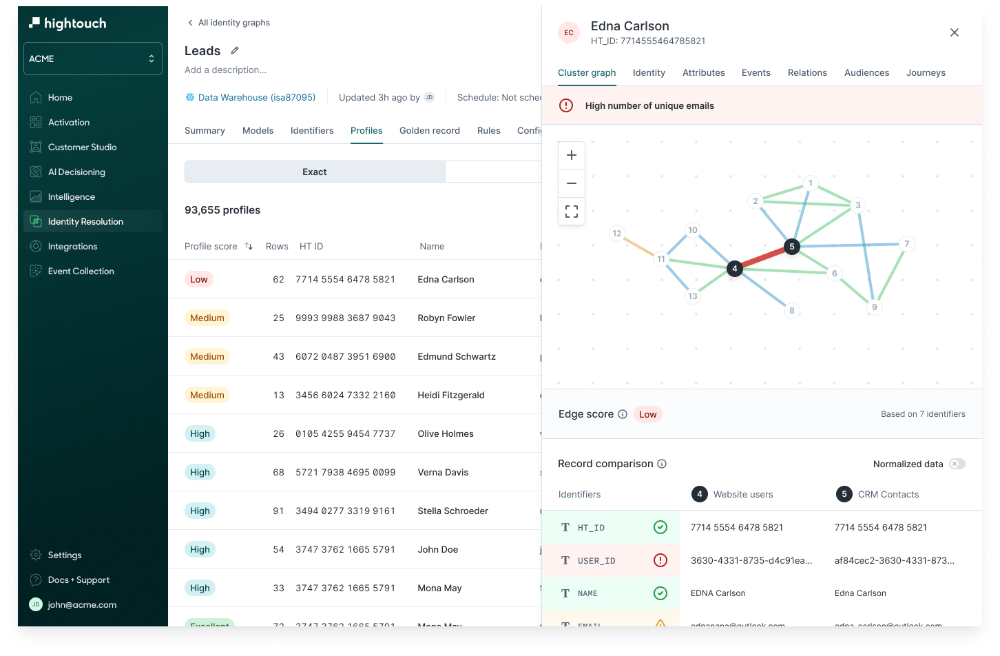The Gist
-
Adaptive data matching. Hightouch launches configurable deterministic and probabilistic identity resolution.
-
Warehouse integration. Identity resolution now operates natively within customer data warehouses.
-
Business impact. Helps brands unify fragmented customer records improving marketing effectiveness and personalization.
Hightouch released Adaptive Identity Resolution on July 1, a new capability for its warehouse-native Customer Data Platform. The technology aims to help brands unify fragmented customer data across devices, platforms and identities.
The solution introduces what Hightouch calls "multi-zone" identity resolution, allowing businesses to switch between high-confidence deterministic matching and higher-reach probabilistic matching within a single project setup. According to company officials, this approach addresses the persistent challenge of maintaining clean, accurate customer data as consumers engage across multiple devices, emails and channels.
Table of Contents
- Impacted Audiences for Adaptive Identity Resolution
- CDP Market Evolution
- Hightouch co-CEO: Identity Resolution Should Adapt to Each Situation
- Hightouch Background
Impacted Audiences for Adaptive Identity Resolution
-
Data engineers managing complex data workflows
-
Marketing teams seeking to unify customer profiles
-
Organizations with fragmented customer data across platforms
CDP Market Evolution
Customer data platforms are evolving beyond their original form as businesses demand more control, ownership and flexibility in how they unify and activate customer data.
CDPs that emerged between 2016 and 2020 have reached limitations, prompting a shift toward cloud-native solutions that integrate with data warehouses like Snowflake and Databricks. While traditional CDPs unified customer data from various sources, industry experts note they face growing competition from integrated marketing and CRM systems, with some suggesting the CDP category is past its peak hype cycle. A significant challenge with off-the-shelf CDPs is that first-party data collected often doesn't truly belong to the company using the platform.
The market is now embracing warehouse-native approaches that preserve data ownership while leveraging AI for deeper analytics and personalization. Hightouch, founded as a reverse ETL company, has expanded into this evolving CDP landscape with its warehouse-native platform. Their new Adaptive Identity Resolution capability aims to address fragmented customer profiles while maintaining the benefits of warehouse-native architecture.
Related Article: CDPs Uncovered: Integrations, AI and the Path Forward
Hightouch co-CEO: Identity Resolution Should Adapt to Each Situation
We've built something entirely new, a multi-zone identity engine that lets customers toggle between high-confidence deterministic graphs and higher-reach probabilistic graphs, without sacrificing transparency or control. The ways you use customer identities are situational; Adaptive Identity Resolution adjusts to fit each situation.
- [Tejas Manohar, co-founder and co-CEO of Hightouch

Key Capabilities of Adaptive Identity Resolution
Hightouch’s new solution introduces flexible, warehouse-native identity resolution features designed to improve customer data accuracy and marketing personalization.
| Capability | Description |
|---|---|
| Multi-zone matching | Toggle between precision and reach based on use case needs |
| Warehouse-native architecture | Perform identity resolution directly in the data warehouse |
| Configurable matching | Fine-tune logic and inspect machine learning decisions |
| Real-time activation | Deploy merged profiles across marketing channels |
| Transparent processing | Maintain visibility into how profiles are matched |
Hightouch Background
Hightouch, founded in 2020 in San Francisco, targets data and marketing teams looking to operationalize data from cloud warehouses. The company has received venture funding from investors including ICONIQ Growth and Amplify Partners.
Data Activation Tools
Hightouch offers a data activation platform that enables organizations to sync data from cloud data warehouses to business applications such as customer relationship management (CRM) and marketing automation tools. The platform's core capability is reverse ETL (extract, transform, load), which they assert allows users to push data into operational systems without engineering resources. Hightouch supports integrations with major data platforms and provides features for audience segmentation and personalization.
Market Positioning
The company is positioned in the data integration and activation segment, serving mid-market and enterprise organizations with modern data infrastructure. Typical customers include digital-native businesses and enterprises seeking to leverage cloud data for marketing, sales and customer success. Hightouch asserts that its platform helps reduce data silos and improve time-to-value for analytics investments.
Have a tip to share with our editorial team? Drop us a line:
